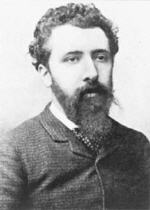
Seurat was born in Paris, 1859, died at the young age of thirty-one(1891), cutting his career as an artist (1882-1891) to under a decade. In his artwork, Seurat sought to return to the permanence and reflective nature of classical art that had been abandoned for the spontaneity of Impressionism. This goal was reflected in his painting methodology: Seurat would spend months planning a single canvas, drawing and redrawing studies and sketches. Due to his slow, meticulous method of painting, Seurat painted less than ten major works in his career. Nevertheless, his work and his divergence from the Impressionist view of art were influential in the development of Neo-Impressionism and subsequent art movements.
In 1878, Seurat enrolled at the Ecole des Beaux-Arts in Paris where he studied classical art under Henri Lehmann, a pupil of Ingres. However, after only a year and a half of formal training, Seurat left to pursue his own independent study to systematize the use of color. He took notes on works by Puvis de Chavannes and Delacroix and he read the aesthetic treatises of Michel Chevreul, Charles Blanc, O. N. Rood, and others. He systematize the methods used empirically by Corot and the Impressionists.
His first major painting, Bathers at Asnières (1883 - 4), was rejected by the Paris Salon in 1884 but exhibited by the newly formed Groupe des Artistes Indépendants. At the 1884 exhibition, Seurat met Signac and Henri-Edmond Cross, who collaborated with him in developing the method of Pointillism, the use of tiny dots of complimentary colors to create vibrant colors. The pointillist method was employed in his second major painting, Sunday on the Island of Grande Jatte (1884-6) which was exhibited at the eight and last Impressionist exhibition in 1886. Only a few months afterwards, Seurat began work on Models, which he exhibited in 1888 at the fourth exhibition of the Societe des Artistes Independants.
Seurat's changing social circle may have been influential in causing Seurat to gain an interest in politicizing the message of his works while losing interest in the innovation of color. Before the exhibition of Bathers in 1884, Seurat was good friends with Edmond Aman-Jean, a friend that Seurat knew from the classical art school the Ecole de Beaux Arts. (Leighton 14) However, from the exhibition onward, Seurat became good friends with artists such as Paul Signac, Camille Pissarro, Henri Edmond-Cross, and others. (Herbert 83) These artists, most of who belonged to the Societe des Artistes Independants, were more radical than Seurat's Ecole friends both artistically and politically. In October 1885, Seurat also became friends with a group of writers known as the Symbolists who sought to revolutionize their art by emphasizing "the evocation of mood and underlying reality rather than the precise rendition of nature". (Leighton 133) Seurat became so involved in this social group of artists and writers that from 1886 onwards, "Seurat effectively belonged to a small and esoteric avant-garde whose activities were confined almost exclusively within a square kilometer". (Smith)Though hardly anything is known about the political beliefs of Seurat, journalist Felix Feneon argued by default that "one can assume that Seurat shared the views of his friends, because his literary and artistic comrades…belonged to anarchist circles, and if his opinions had been opposed to theirs it would have been noticed." (qtd Thomson 95) Whether or not Seurat was a leftist, after the 1884 exhibition of Bathers, he was increasingly exposed to anarchism and criticisms of the bourgeoisie. This may have contributed to his interest in satirizing the bourgeoisie as he did in Grande Jatte, and contrasting them with working class as he does in Models.